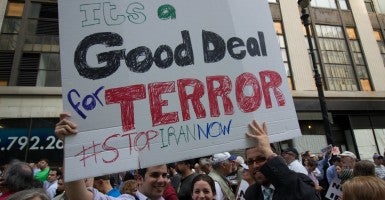It turns out the Iran nuke deal is a lot like the guy or gal you spy across the room at a dimly lit party who from afar seems quite alluring—that is, until you get closer and realize the object of your affection isn’t what you had hoped for.
Not by a long stretch.
For instance, the original idea of a nuclear agreement with Tehran started out with the goal of Iran trading its nuclear (weapons) program for an end to punitive economic sanctions slapped on it by the international community.
We didn’t get that.
What we got instead was basically a less-than-full “freeze” or a partial “pause” on Iran’s nuclear program—not an end to the ayatollahs’ atomic affairs, much less their ambitions.
While some aspects of it may be altered, Tehran’s nuclear infrastructure won’t be dismantled and carted away as many expected it would be.
No wonder Iran’s president, Hassan Rouhani, last week crowed that Iran had achieved a major goal in the Vienna talks by being allowed to continue nuclear activities, according to Iranian media.
Worse, Iran will remain a nuclear (weapon) “threshold” state.
Indeed, a former International Atomic Energy Agency nuclear inspector told German broadcaster Deutsche Welle that “after 10, 15 years it [Tehran] will have even more nuclear capabilities than before.”
How could that be?
Well, that’s because under the Vienna agreement, Tehran will be authorized to conduct enrichment research and development on advanced, more efficient centrifuges, key to enriching uranium and building a bomb.
It’s probably worse.
With the release of $100 billion in energy assets and its reintegration into the world economy after initial pact obligations are met, Iran will move from being a poorer nuclear threshold state to being a richer nuclear threshold state.
In other words, even if Iran doesn’t violate the deal before its 10- to 15-year “sunset,” when the restrictions on atomic activities end, Tehran will be in a better position to pursue the bomb than they are today under existing, painful economic penalties.
Some argue Tehran will go from a few years before it’s able to “break out” (translation: build the bomb) now, to a one-year breakout time under the Vienna deal, to a near-zero breakout time when the sun sets on the deal—due to the benefits Iran will receive and the centrifuge R&D it is able to conduct.
That’s pretty unnerving, especially considering the anti-American, anti-Israeli venom the Iranians are still spewing out.
Over the weekend, Iran’s Supreme Leader Ali Khamenei promised to oppose U.S. Middle East policies in a speech “punctuated by chants of ‘Death to America’ and ‘Death to Israel’,” according to Reuters.
With congressional briefings soon, Secretary of State John Kerry had to admit on Saudi Arabia’s Al Arabiya TV that Khamenei’s comments were “very disturbing,” coming on the heels of the historic nuclear agreement with Tehran.
From this one might conclude that the troubles with Tehran aren’t over (see my July 17 op-ed in the Boston Herald, “Terror state will likely ramp up Mideast mischief”).
In fact from the looks of it up close this nuke deal won’t make our Persian problems any better—in reality it will probably make them a lot worse.
Originally published in The Boston Herald.






























